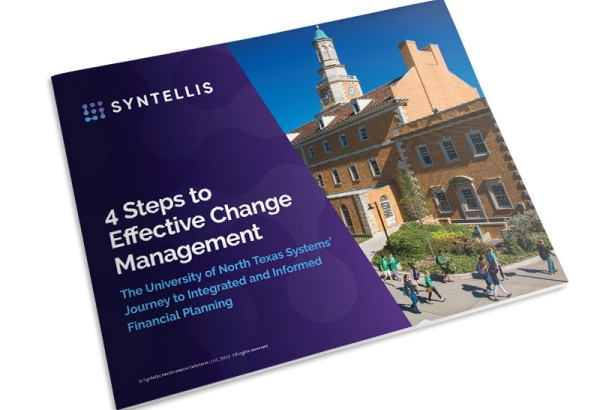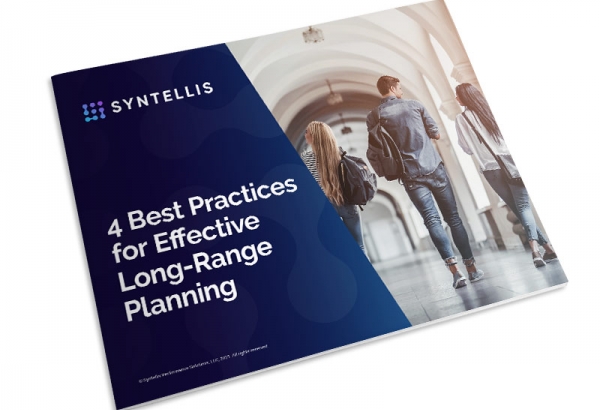Accurate, data-driven budgeting and long-range planning are key to growth and financial health for colleges and universities. However, many institutions still rely on manual or paper-based processes, which hinder collaboration and execution of financial plans.
The COVID-19 pandemic magnified these flaws in colleges’ legacy processes and technology, as institutions struggled to respond to quickly changing circumstances and develop long-term financial strategies.
While the pandemic did help accelerate the adoption of technology at some institutions, Syntellis’ 2023 CFO Outlook for Higher Education report found that 60% of higher education finance leaders believe higher education is behind other industries in adopting modern budgeting and financial planning tools.
But what does this digital transformation look like at actual colleges and universities, and how do they benefit? Western Kentucky University and Springfield College leaders share their tips and benefits of implementing modern budgeting and planning technology below.
1. Create a Central, Trusted Data Repository
In Syntellis’ survey of higher education CFOs, 30% of respondents said that accessing reliable data is their most significant reporting challenge. This is because most colleges and universities lack a single, trusted source of truth for all their financial data.
Renaldo Domoney, Assistant Vice President for Budget, Finance, and Analytics at Western Kentucky University (WKU), explains that when he introduced charts and tables to a conversation, much of the discussion would center around where the data came from and whether it was trustworthy, rather than how the institution could use it.
Axiom™ Budgeting and Forecasting aggregates data from various systems and across multiple schools and departments, providing a single, trusted source of information and insight. This empowers decision-makers to focus more on how to apply the data, rather than on whether it is accurate and trustworthy.
“When we all see the same numbers, we can start talking strategy,” Domoney says.
2. Deliver Immediate Insights for Faster Decision-Making
In the early stages of the COVID-19 pandemic, things changed quickly as new information became available. “Getting information fast was important, and we struggled with that,” explains Domoney. At that time, WKU was in the initial stages of evaluating new budgeting software, and their struggles during COVID reassured the team that implementing new technology would benefit the institution.
Anthony Mutti, Chief Information Officer at Springfield College, experienced similar struggles and began the process of replacing the institution’s enterprise resource planning (ERP) application during the height of the pandemic.
“The information wasn’t there; it took too long,” he says, explaining that with their current technology, it often took days to gather and vet data, which slowed decision-making. “That just wasn’t sustainable, and wouldn’t allow us to grow in the way that we wanted to grow. It became very obvious very quickly that we needed a change.”
Those experiences aren’t unique to WKU and Springfield College — still today one-third of higher education finance leaders say they don’t have the right budgeting and planning tools to respond quickly to changing conditions.
WKU and Springfield College have both since adopted advanced budgeting and planning technology from Syntellis, so finance leaders have the right data at their fingertips. With nightly data imports, both institutions can generate daily reports to ensure they have up-to-date information to make informed decisions quickly.
3. Overcome Labor Challenges With Automation
Higher education heavily relies on people to fulfill its mission — employment makes up about 60% of institutions’ annual spend. However, many colleges and universities currently struggle with hiring and staff retention. In one survey, one-third of higher education employees said they are likely or very likely to seek new employment within the next year. That can have a snowball effect across an institution and it’s no surprise to higher ed CFOs: 96% say that labor challenges have a moderate to significant impact on budgeting and financial planning.
“One of the ways you can mitigate some of those difficulties is to find opportunities to simplify and automate processes,” says Mutti. “So that you don’t need as many people and the people you do have can do more meaningful work.”
Technology empowers colleges and universities to automate a wide range of manual financial processes that would otherwise take up valuable time and resources. For example, with automated report production, available in Syntellis’ Axiom Higher Education Suite, institutions can monitor and manage institutional performance without IT involvement.
4. Look Beyond the Current Financial Year to Make Long-Range Decisions
As the higher education landscape continues to change, many colleges and universities make tough decisions based on outdated information, rather than anticipating challenges and creating a proactive strategy to address them. Even prior to the pandemic and enrollment challenges, institutions often postponed important initiatives to stay on budget.
“You might defer maintenance or technology spending because those things are easy to cut out of a budget,” says Mutti. “But in the end, they just stack up.” After postponing for several years, investments compile and become difficult to absorb into an annual budget.
Axiom empowers colleges and universities to create long-term financial plans to drive institutional sustainability and financial health. WKU, for example, uses Axiom to create proactive rather than reactive plans that focus on aspects beyond day-to-day operations, such as enrollment, growth, and new programs.
“That long-term financial plan, coupled with an incentive-based decentralized budget model, should put us in a pretty good position,” says Domoney.
Accurate, data-based long-term planning guides institutions to pursue the right actions and investments to continue on a positive growth trajectory.
Especially in anticipation of continued enrollment challenges, colleges and universities must strive to remain competitive, which requires a nimble and proactive strategy for the future. Equipped with advanced data and analytics tools, such as the Axiom Higher Education Suite, institutions can take appropriate, calculated risks to adopt new programs and initiatives that will lead to growth and continued financial health.
Learn more about Axiom in higher education

4 Steps to Effective Change Management

4 Best Practices for Long-Range Strategic Financial Planning


